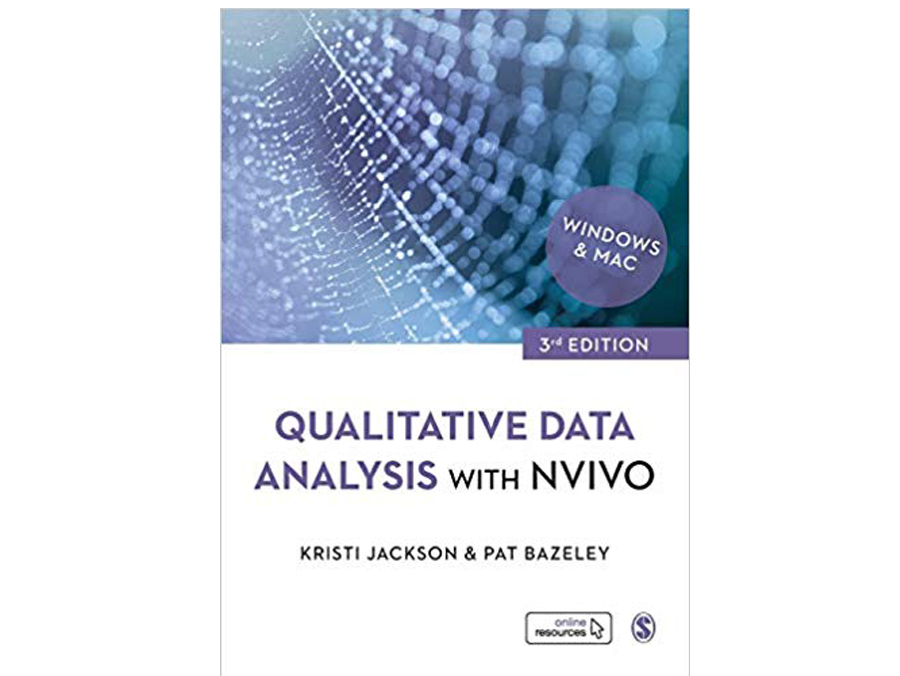Reviewed by Kay Corry Aubrey, Design Researcher, Usability Resources Inc., Bedford, MA, Kay@UsabilityResources.net
Qualitative researchers who deal with large and complex projects should look at tools like NVivo, Dedoose, Atlas TI, and MaxQDA to help them organize and structure information more effectively. These products belong to a category of technology called Qualitative Data Analysis Software (QDAS). NVivo is probably the most mature of the group and, with the new edition of this practical and comprehensive guide, the most accessible. Qualitative Data Analysis with NVivo 3rd edition by Kristi Jackson and Pat Bazeley offers easy-to-follow, step-by-step instructions (with screenshots) for how to use NVivo’s key features as well as guidance on how to incorporate this powerful tool into your workflow.
QDAS allows you to combine digitized files such as spreadsheets, transcripts, photographs, social media posts, and video surveys into a single project that you can code and structure for analysis. Once you’ve given the project files structure, you can then run queries against the entire dataset to uncover insights and explore relationships across media types. QDAS tools are indispensable for complex projects such as longitudinal studies and persona research, studies that involve many phases, or that require blending results from work done by different researchers. With QDAS/NVivo you give structure to unstructured information, which introduces rigor that allows you to compare apples to apples, and directly retrieve quotes, images, video clips, survey results, and so on to support your claims.
Kristi Jackson, the lead author of this edition, is a QRCA member and a qualitative senior scientist at Optum. Prior to Optum, Kristi was an independent social science researcher and NVivo trainer through her company Queri. Pat Bazeley is director of research support and a professor at Western Sydney University. Both women have decades of experience working with NVivo.
NVivo is very flexible so you can reorganize information as your thought process evolves. The authors do a great job of laying out the different ways to structure, connect, and tag data through sets, folders, cases, classification sheets, and other mechanisms. Their chapters on coding (which is like tagging) are particularly helpful. They suggest fluid strategies for how to approach the coding task to make it part of the learning process a researcher goes through as they mine for insights in a mountain of information. They recommend identifying what is interesting to you; looking for repetition and regularities; making comparisons; asking who, what, when, where, why, and how questions to pinpoint themes and relationships. The getting started part is always the hardest. Coding becomes easier as you dig deeper into your data. The authors suggest keeping track of how your thought process evolves by writing memos.
They show automated ways to generate codes via queries and autocoding, and how to use visualizations to get a bird’s eye view of your overall coding scheme so that you can adjust as you go along. They also show you how to weave together qualitative and quantitative results for analysis. The authors guide you through complex (but powerful) features such as setting up Classification Sheets and running Matrix Coding Queries that produce cross-tabbed results for comparisons or to unearth non-obvious patterns in the data.
The third edition of this book is full of new material. It now covers NVivo 12 for both Macintosh and Windows, and instructions on how to incorporate social media listening research into an NVivo project. The authors describe techniques for drawing and weaving together data from Twitter, Facebook, YouTube, web pages, and online communities, and reference instructional videos they prepared and many other resources to extend your learning. The instruction on the key features and methods has also been enhanced.
This would be a useful book for QRCs at any skill level. It does a great job of demonstrating when it makes sense to use this tool and the value it would deliver. Beginners will gain an understanding of NVivo for a project, while occasional and more advanced users can leverage it as a reference or for a deeper understanding of certain features.


Be the first to comment